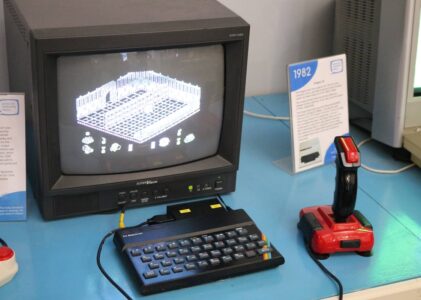Introduction
The ZX Spectrum, an iconic home computer released in the early 1980s, played a pivotal role in shaping the world of video games. Its vibrant 8-bit graphics and unique sound capabilities brought countless hours of joy to gamers of that era. However, beneath the surface, the Spectrum harbored a set of hardware limitations that posed formidable challenges to game developers. In this exploration, we will delve deep into these limitations and uncover how they influenced the evolution of game development.
The Birth of ZX Spectrum
Before we plunge into the hardware limitations, let’s take a moment to appreciate the significance of ZX Spectrum in the history of gaming. Released by Sinclair Research in 1982, the ZX Spectrum was a successor to the ZX81, offering significant improvements in both performance and functionality. With a vast library of games and an affordable price point, it quickly became a household name.
1. Memory Constraints
One of the most glaring limitations of the ZX Spectrum was its memory. The early models, such as the ZX Spectrum 16K and 48K, had a mere 16 kilobytes of RAM. This severely restricted the amount of data that could be loaded into memory at any given time. As a result, game developers were forced to work within these tight constraints.
This memory limitation led to several creative workarounds. Developers had to carefully manage memory usage, often loading different game sections as needed and swapping data in and out of the limited RAM. It required meticulous planning to ensure that the game didn’t crash due to insufficient memory.
2. Color Palette
The ZX Spectrum’s color palette was another significant challenge for game developers. It supported a total of 15 colors, but the limitations of the hardware meant that only two of those colors could be used in any 8×8 pixel block. This constraint made it challenging to create visually appealing and diverse graphics.
Despite the limited color choices, developers found ways to maximize the visual impact of their games. Dithering techniques, where patterns of pixels of two different colors were used to create the illusion of additional shades, became a common strategy. The result was games with a distinctive, albeit somewhat pixelated, aesthetic.
3. Sound Capabilities
Sound was yet another hurdle for game developers on the ZX Spectrum. The computer’s built-in sound hardware was rudimentary, producing simple beeps and tones. Unlike some of its competitors, such as the Commodore 64, the Spectrum couldn’t generate complex musical compositions or rich sound effects.
To overcome these sound limitations, developers had to get creative. They often used the limited sound capabilities to their advantage, crafting memorable chiptune melodies that, while simple, became iconic in their own right. It was a testament to their ingenuity that they could create engaging audio experiences within these constraints.
4. Processing Power
The ZX Spectrum’s processing power was modest by today’s standards. Its Z80A CPU ran at a clock speed of 3.5 MHz, which limited the complexity and speed of calculations it could perform. This had a direct impact on the gameplay experience, as more demanding games often suffered from slowdowns and flickering graphics.
Developers had to optimize their code to make the most of the limited processing power. They employed various techniques, such as assembly language programming and efficient algorithms, to ensure that their games ran smoothly. These efforts sometimes resulted in games that pushed the hardware to its limits, providing players with thrilling experiences.
5. Loading Times
One of the most frustrating aspects of ZX Spectrum gaming was the loading times. Games were typically distributed on cassette tapes, and loading a game could take several minutes. This was a far cry from the instant gratification we expect from modern gaming.
Developers had to strike a balance between game size and loading times. Larger games with more complex graphics and gameplay had longer loading times, which risked testing players’ patience. Some developers incorporated mini-games or interactive loading screens to keep players entertained while they waited.
The Legacy of ZX Spectrum
Despite these hardware limitations, the ZX Spectrum left an indelible mark on the gaming industry. Its thriving developer community produced a vast array of games that showcased remarkable creativity and ingenuity. The constraints of the hardware inspired developers to push boundaries and think outside the box.
6. Community and DIY Spirit
The ZX Spectrum community was known for its DIY spirit. Aspiring programmers and developers found ways to expand the capabilities of the hardware through add-on devices and custom peripherals. These innovations paved the way for a more versatile gaming experience, as well as contributed to the evolution of personal computing.
7. Cult Classics
Many of the games developed for the ZX Spectrum are considered cult classics today. Titles like “Manic Miner,” “Jet Set Willy,” and “Dizzy” are still celebrated for their unique gameplay and distinctive graphics. These games managed to transcend the limitations of the hardware, becoming beloved gems in the gaming world.
8. Learning and Innovation
For many developers, working on the ZX Spectrum was a formative experience. The challenges they faced forced them to think critically and creatively, honing their programming skills. This generation of developers would go on to shape the future of the gaming industry, contributing to the birth of new platforms and technologies.
ZX Spectrum hardware limitations
In retrospect, the limitations of the ZX Spectrum hardware were both a blessing and a curse for game development. While they presented formidable challenges, they also fostered a culture of innovation, creativity, and perseverance. The games that emerged from this era continue to hold a special place in the hearts of gamers worldwide, reminding us of the remarkable achievements made within the constraints of 8-bit technology.
For more insights into the world of vintage gaming and the enduring impact of the ZX Spectrum, check out the following links:
Remember, the limitations of the ZX Spectrum hardware were not obstacles but stepping stones to innovation, and the games that emerged from this era remain timeless classics.













